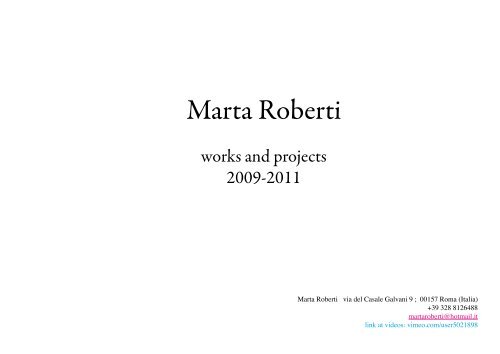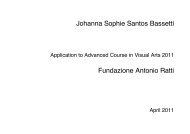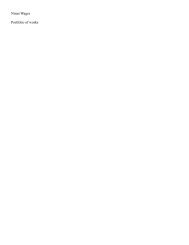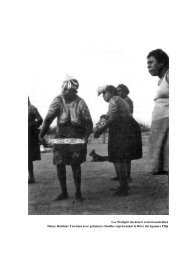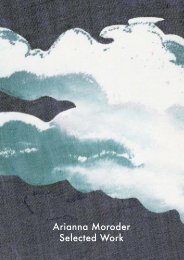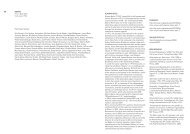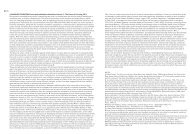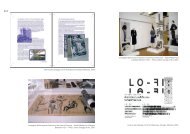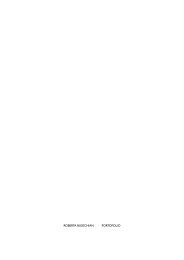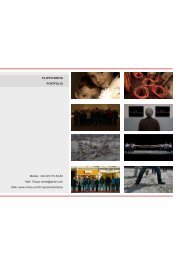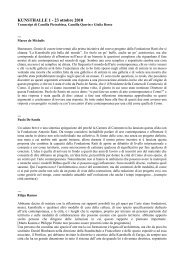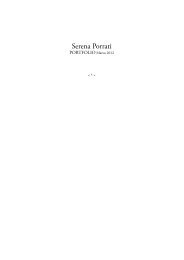Marta Roberti - Fondazione Antonio Ratti
Marta Roberti - Fondazione Antonio Ratti
Marta Roberti - Fondazione Antonio Ratti
You also want an ePaper? Increase the reach of your titles
YUMPU automatically turns print PDFs into web optimized ePapers that Google loves.
<strong>Marta</strong> <strong>Roberti</strong><br />
works and projects<br />
2009-2011<br />
<strong>Marta</strong> <strong>Roberti</strong> via del Casale Galvani 9 ; 00157 Roma (Italia)<br />
+39 328 8126488<br />
martaroberti@hotmail.it<br />
link at videos: vimeo.com/user5021898
ways and places of research<br />
My approach is based on the intersection between art and philosophy. The heart of my interdisciplinary work is a series of hand-drawn animations,<br />
and some philosophical texts, in which I care to investigate the issues that have to do with the subjectivity in contemporary society, with<br />
special emphasis on the indefiniteness of human nature and its potential and neotenic essence (a chronic childhood). I am especially interested in<br />
the constant modelling that learning effects on human lack of completeness, and particularly the lack of a fixed end-point. This species- specific<br />
characteristic of the human animal is radically historicized in today’s temporary, fragmentary modes of existence, subject to a never-ending redefinition<br />
brought about by lifelong learning and education processes.<br />
It is for me a trespassing between art and philosophy, which wants to suggest a nomadic attitude : as an artist I use philosophical inquiry’ method<br />
and, conversely, as a philosopher, I use the tools of art. In this sense, the hand drawings with which I made the videos, are an alternative to writing<br />
essays, classically provided by the methodology of philosophical inquiry.<br />
Another central element that characterizes my work is to proceed exclusively through practices of manually drawing, which provide a very long<br />
time (from half year to one year depending from the video lenght) for the realization of video animations, that I realize by myself from drawings<br />
to photography and video editing. Only with regard to music or sound I look for the collaboration with other artists.<br />
Another recurring concept underlying my work is connected to the phenomenon of different repetition, on which video animation itself is<br />
founded, just as are human subjectivity, the body’s habits, memory and time.<br />
The philosophical fabric of my works intertwines with an obsessive hunt for forgotten family albums in flea markets and family videos uploaded<br />
on You Tube. I am interested in finding recurring elements and figures that are repeated in people’s self-representations.<br />
I am fascinated by how every family photo album looks interchangeable: leafing through a stranger’s photo album we can always find features<br />
that are familiar to us. This moment of recognition brings about a kind of depersonalization. In Virginia Woolf ’s words, this shall be childood; but<br />
it has not be my childood.
pierrot<br />
2011<br />
hand drawing animation<br />
It is a narration inspired from PENIS ENVY described by Sigmund Freud. some little boys, dressed as pierrot in a snowy wood, during their Oedipus complex,<br />
compete on how long they can piss. The little girl doesn’t want to mesure her self as the boys, so she makes a drawing in the snow with her piss.<br />
I wanted to overturn the supposed female’ penis jealousy into a different form to solve conflicts not based on competiotion but on creativity.<br />
I’m working now on this project not finished yet.
pierrot, frame dal video
pierrot, frame dal video
pierrot, frame dal video
pierrot, frame dal video
pierrot, frame dal video
environment becoming<br />
(waiting women)<br />
http://vimeo.com/18421555<br />
video installation of<br />
hand drawing animations<br />
project 2010
from Eugene Minkowski Lived time: phenomenological and psychopathological<br />
studies.<br />
“The vital phenomenon which is opposed to activity, while if it is<br />
situated on the same plan, is not passivity, but waiting.<br />
Naturally here we are not considering waiting for a precise moment<br />
that, according to our prevision, has to happen in a specific moment,<br />
for example a train that has to pass in half an hour. This is a waiting<br />
full of measurable time […]<br />
In waiting there’s not duration, there’s not time organisation....<br />
[…] Activity and expectations determine the general attitude of the<br />
individual in the world. If in activity, unfolding in the empty I’m<br />
almost a whole, if in expectation I am reduce to my simple expression<br />
and under the threat of being swallowed up by environment becoming<br />
I am almost nothing, it is probably thanks to the combined action of<br />
activity and expectation that I am what I am...”<br />
environment becoming, video still, drawing on graphite paper
environment becoming , video still, drawing on graphite paper
This plan derives from a research that I used to do in flow markets where I find<br />
old photos from 1890 to 1960: I have found a lot of pictures representing women<br />
that in a wild nature seems captured from a vision, waiting for something that not<br />
arrives: women present themselves suggesting a melanchonical and not solved<br />
waiting.<br />
Minkowsky says that the vital phenomenom which is opposed to activity is not<br />
passivity but waiting. He says that in expectation I am reduced to my simple<br />
expression and under the threat of being swallowed up by environment becoming<br />
I am almost nothing .<br />
The border between a subject and an object does not still exist while we are waiting.<br />
Through the animation of the drawings in my video installacion I’ve forced<br />
this sensation of ambient becoming in a pose of expectation: women are represented<br />
in a way that does not favour the human presence in the ambient, infact in the<br />
drawings women are not different from nature, they are nature like the trees, the<br />
ground and the sky.<br />
In these animated drawings I’ve subverted the movement intended as a transfer<br />
of a character from one spot to another against a fixed background. I try to think<br />
movement as an uninterrupted, fluid metamorphosis of a whole, as the change in<br />
quality of a whole to which the subject belong, in a context in which translations<br />
in space are subject to the becoming of the whole in which they are caught and<br />
that controls the metamorphosis and the direction of what happens within it. I<br />
call this kind of movement modulation. Movement intended as modulation is<br />
vibration, is a change in quality and consists in the modulation of all the image<br />
components.. Video animations are realized in this special way: I photocopy and<br />
enlarge the photos of waiting women. Aer I trace for around 200 times (200<br />
drawings) the photocopy so to engrave the graphite paper that I’ve put below the<br />
photocopy. I have traced the same picture for 200 times with the purpose to obtain<br />
pictures not much different among them. The drawings always represent the<br />
same scene but every drawing is a little different from the others.<br />
The idea to animate with a ‘vibration’ or modulated movement all the videos that<br />
made up the installacion seems to me successful to characterize waiting time and<br />
poses: immobility, minimal changes of posture.<br />
ambient becoming , video still, drawing on graphite paper
environment becoming<br />
technical description<br />
The video installation will be made up of 4 or 5 video animations,<br />
depending on the place where it is going to be showed. Each video<br />
presents a single woman waiting in a strong nature: women appears like<br />
real presences in a natural size animation. Videos will not be projected<br />
on the wall, but on special sheets used to protect plants in winter called<br />
unwoven fabric, in the middle of the room.<br />
Each animation is in a loop sequence and video projections will be<br />
placed in the same room, or in more than one room, so to create a video<br />
installation in which sound and moving images can have a strong impact<br />
on the public, als absorbed in an expectation of something that is<br />
not going to happen.<br />
environment becoming , video still, drawing on graphite paper
environment becoming, drawing on graphite paper inserted in a glass room, 32x24x6cm
environment becoming, drawing on graphite paper inserted in a glass room, 32x24x6cm
composite bodies<br />
Installation of three drawings on graphite paper 2007<br />
The installation “composite bodies’ is made up of three drawings that reproduce old school photographs of children taken at the beginning of the<br />
last century. The children’s bodies have been arranged in a pose to obtain a deliberately geometric and composited scene.<br />
The three large drawings are made respectively of one, four and eight sheets of graphite paper each measuring 70 x 100 cm. They were obtained<br />
through tracing three photographs previously enlarged to 140cm x 300cm, 140cm x 200cm and 70cm x 100cm respectively, which served as a matrix.
composite bodies serie, 140x300cm, 6 graphite papers
in the classroom, composite bodies serie, 140x200cm, 4 graphite papers
Mother’s shadow<br />
work in progress<br />
old black and withe photos archive<br />
Mother’s shadow is a project that consists to archive old photos from the last century and found in flow markets. In this photos the mother that has<br />
taken the photo to her son projects her shadow on the body of the children.<br />
Mother’s shadow is a title borrowed from a book of the 1970, published by the feminist philosopher of Diotima, a female philosophers community<br />
placed in Verona University. In this book the female philosopers thinks about the contradictory relartionship between mother and daughter,<br />
because they say that is form this relationship that comes female freedom. I transposed this concept in an ironical way.
Neoteny<br />
I’m working on Neoteny with some different projects: video animations and performance such as Neotenic, Educanda (Girl boarder), and<br />
Knowing that we do not know.<br />
Neoteny is a term defining the perpetuation of childhood features in adult individuals which philosophers and sociologists, such as the Italian Paolo<br />
Virno, sustains that the chronic infant, that is to say, never achieves a stage by which he is to be considered definitive, but continuously behaves<br />
under a redefinition due to his lack of specialized instincts which other animals are supply with. Thus, it is the comparison with other animals what<br />
makes it possible to refer to human being as the most incomplete and non-adapted amongst the terrestrial creatures. The other animals live in their<br />
environment as though using a prosthesis, knowing quite well what to do about it; the human being does not live in such rigid spheres and his vital<br />
habitat is the world where he develops an essential existential experience, namely, learning. Chronic infancy is a natural state of the human animal,<br />
and every society of any age has attempted to moderate by rite-like repetitive devices, along with work engagement which does not plainly expose<br />
it. In a contemporary society what prevail is processes that expose this neotenous structure, with its features of intermittence and precariousness,<br />
flexibility and uninterrupted development.
Knowing that we do not know<br />
2010<br />
performance and video<br />
The peculiarity of this performance is in the age of the participants as it is open only to men and women over seventy. It consists in private philosophy<br />
lessons taken in any place of a city: square, bar, street, train... When I found an old man or woman alone in a public space (garden, train,<br />
street...) I ask him/her if he/she wants to listen and partecipate to a philosophical lesson. I record with a small video camera on a tripod all the<br />
conversations between me and the woman or the man that deciced to partecipate at the performance.<br />
The focus of my lesson is Socrates’ famous formulation: I KNOW THAT I KNOW NOTHING. We don’t know anything except our own<br />
ignorance: this is the main issue that the lesson explores, and the elderly talks about their own experience about to doesn’t Know .<br />
Lessons take place in an open and public space so as to evoke the oral and public dimension of Socrates’ teachings. Socrates never wrote philosophical<br />
texts, he was in fact the champion of oral modes of communication. The final aim of the project is to realize a video through a montage of<br />
this lessons.<br />
We can say that Philosophy was born in Greece with Socrate’s admission of ignorance in the V sec. a.C. Socrate teaches that we never have<br />
a complete knowledge and that is important to know that we don’t know. He has understood to be the most intelligent in Athen because he<br />
knows that he has no intelligence. Others persons deceive themself: they believe to be intelligent but they have no Knowledge; Socrate at least<br />
has a Knowledge in fact he Knows that he doesn’t Know. This concept is analogue to the concept of neoteny, that means never achieves a stage
Neotenic http://vimeo.com/16051542<br />
hand drawing animation with watercolours<br />
2:38 min.<br />
dvd pal 2009<br />
Neotenic is a video animation composed of several hundreds of drawings realised by watercolour technique. The woman’s movements whose overweight<br />
body recalls those of Willendorf ’s Venus, faithfully reproduce a baby’s movements who is learning to keep an upright position and attempts<br />
to walk. The little boy I was inspired by is one amongst the many shot mothers on the four corners of the world, uploaded on youtube.
Educanda (Girl boarder)<br />
http://vimeo.com/16051470 2009<br />
stop motion video animation with plasticine<br />
2: 14 mins.<br />
dvd pal<br />
Girl Boarder is a stop motion video animation created for a small screen or television set. A little girl made with Plasticine was set in a scene<br />
reminiscent of the photographs of pupils which used to be taken on their first few days at school: a map in the background, a table with a notebook<br />
on which the pupils’ hands were to rest neatly, the black school smock. This iconography recurred in 1940s photographs which I found,<br />
but it may originate even further back in time. I myself am portrayed in the same way in a 1980s school photograph.<br />
The video consists of a single shot of the girl sitting at her desk reading a complicated philosophy text. The character’s voice is lent by a seven<br />
year old girl who at my request read this passage dealing with human nature intended as neotenic, never defined and always potentially alterable<br />
through learning. The schoolgirl’s reading appears like a struggle against the words and sentences whose meaning escapes her. Despite not<br />
knowing the meaning of the sounds that her voice articulates, the girl is visibly striving to achieve self-discipline and comply with the school’s<br />
requirement that she performs the task to the best of her abilities. She cannot understand what she is reading, as the language of philosophy<br />
removes words from the materiality they possess in pre-school language, where words embody objects. School brings about a deportation from<br />
that world in which no ri exists between words and objects: the girl who is reading is obedient, she struggles to learn adults’ language, but is<br />
represented in the process through which she endeavours to take on a different form and leave her own.
Lacuna (Gap) http://vimeo.com/21516427<br />
2008/2010<br />
hand drawing animation with carbon paper<br />
4: 5o mins.<br />
music by ALva Noto<br />
dvd pal<br />
video projection in a dark room<br />
The title Lacuna plays on the etymological meaning of the term ‘lacuna’, intended both as lack, gap, absence, a state of pure will and indeterminacy, and as a pond or lagoon,<br />
where the video animation is set. This video has been done for my diploma in the Art Accademy, so that is accompained by a philosophical text : Places and figures<br />
of the repetition, that has been published in 2010. The video and the thesis are strictly connected. Both are a sort of journey through some philosophical and literary<br />
places where the phenomenon of repetition is clearly evident. Animation is actually a process of repeticion of drawings thare are slightly different from each other. In my<br />
animation I use a tecnique I call modulation which consists in the repeticion of the same drawing, without any fixed background behind the character. This techique<br />
involves repeticion as both material and phisical procedure, but also the theme of the narration in Lacuna: the double, the reflections, memory apparitions, the past<br />
reflected in the present, dejà-vu, the body’s cyclic return to nature from which it originates.
the artists<br />
2007<br />
photograph printed on cotton.<br />
100x140cm<br />
What is art? Who is an artist? This work born from these question. My father is a plein air painter. I’ve found these photographs in his album.<br />
The photographs represents my father and his friends painting at the beach.<br />
My father and his friends call each others ‘artist’. My father doesn’t know contemporary art, but he has represented to me ‘the artist’ for a lot of<br />
years. The way he has presented me what he calles art, has been the motivacion of my being far from art until I was 20, when I’ve understood<br />
that can be an artist also who is not a good painter.<br />
In this sense I’ve used photoshop to transform this photos into paintings.
MARTA ROBERTI born in Brescia (ITALY) 08/12/1977 l<br />
Live and works in ROME(ITALY), VIA DEL CASALE GALVANI 9, 00157<br />
martaroberti@hotmail.it tel.+39 3288126488<br />
EDUCATION<br />
2005-2008 – DEGREE in ART and TECHNOLOGY : BRERA ART ACCADEMY, Milano. CINEMA AND VIDEO department VOTE: 110 cumlaude/110 TESI<br />
PRINTED (relators <strong>Antonio</strong> Caronia e Andrea Lissoni)<br />
2002 -DEGREE in PHILOSOPHY: Faculty of PHILOSOPHY - Verona. VOTE:110 cumlaude/110TESI PRINTED (relator Chiara Zamboni)<br />
2006-2008). MASTER FIRST LEVEL: ART ARCHITECTURE AND TERRITORY: interfaculty master between Architecture faculty, Roma 3 Accademy of Art<br />
(Brera-Milan) TESI PRINTED<br />
1996: SENIOR HIGH SCHOOL SPECIALIZING IN SCIENCE EDUCATION, , Giacomo Perlasca Institute, Idro (Bs) Italy.<br />
LENGHTY STAYS ABROAD<br />
BARCELONA 1998: 1 YEAR ERASMUS, PHILOSOPHY FACULTY<br />
BUENOS AIRES 2004 : 1 YEAR PHILOSOPHY TEACHER , ITALIAN CULTURAL INSTITUTE .<br />
PUBLISHED ESSAYS ABOUT ART AND PHILOSOPHY:<br />
-REPETICION’S FIGURES AND PLACES, publicated by CASVA, ( High visual art studies centre) Milano, 2010<br />
-ART AND GRACE by <strong>Marta</strong> <strong>Roberti</strong>, print in Legàmi. With Gregory Bateson,AA.VV. Editrice universitaria, Verona, University Verona 2006<br />
-WORKING WHILST TALKING, TALKING WHILST WORKING, LANGUAGE AT WORK IN MAURO FOLCI’S WORK. By <strong>Marta</strong> <strong>Roberti</strong>, Stampa alternativa,<br />
Quaderni delle idee, ediz. Speciale del corso di perfezionamento interfacoltà Arte, Roma 2010<br />
ARTICLES<br />
-GENIUS LOCI POWER’, critical text for 20 EVENTI ARTE IN SABINA, 2009.<br />
-BOREDOM, EIDOS, film and psychoanalysis review, september 2010.<br />
MAIN COLLECTIVE EXIBITIONS AND VIDEO SCREENINGS 2009/2011:<br />
2011: -SHOWDESK, NOMAS FOUNDATION curated by sottobosco.<br />
-LIVING SPACES, INTERNATIONAL ART FESTIVAL, Damascus, Sirya, curated by Abir Boukhari (Allartnow)<br />
CONNESSIONI 89, art and teather festival, Milan, Italy curated bu Giulia Brivio.<br />
2010:-FESTARTE, VIDEO ART INTERNATIONAL FESTIVAL: INVISIBILE VIOLENCE; La Pelanda, MACRO (MUSEUM OF CONTEMPORARY ART<br />
ROME), Roma.<br />
-IMMAGINARI VIDEO, VIDEO ART SHOW, curated by Martina Coletti, Gualdo Tadino, Pg.<br />
-VISIONARIO-RESERVOIR DOGS, audiovisual from Galleria Comunale di Arte Moderna di Monfalcone, FESTIVAL BIANCO E NERO, curated Andrea<br />
Bruciati e Eva Comuzzi Udine.<br />
-VIDEOMED, BEEING DIFFERENT IS ABSOLUTELY BEAUTIFUL, FONDAZIONE MERZ, Torino.
-AVVERTENZE GENERALI, MERCATI DI TRAIANO, MUSEO DEI FORI IMPERIALI, ROME, CURATED BY ANDREA FOGLI.<br />
2009: -CORPI NARRANTI: I SENSI DELLA LETTURA, SALA LETTURA DELLA BIBLIOTECA D’ARTE, CASTELLO SFORZESCO, cuated by Cristina<br />
Crivellin and Casva ( High visual art studies centre) MILANO, ITALY.<br />
-APERITIVI D’ARTE al BAR CAMPONESCHI, Piazza Farnese, Roma, curated by Achille Bonito Oliva.<br />
-MILANO IN DIGITALE, FABBRICA DEL VAPORE, selected project show, curated by Cristina Crivellin. Milano<br />
-SALON PRIMO, FABBRICA DEL VAPORE, curated by Brera Art Accademy, Milano.<br />
-EMOTIONS IN MOTIONS, STARS, UNIVERSITY OF SCIENCE AND TECNOLOGY OF THE ARTS, BRESCIA. ITALY<br />
-L’ALTRA LEI, FEMALE CINEMA, CHIASSO, SWITZERLAND, CURATED BY ALINA MARRAZZI.<br />
-VISIONIVIDEO,ARTVERONA, presented by Galleria Fabio Paris, curated by Mariarosa Sossai<br />
-FIAV, FESTIVAL D’IMAGES ARTISTIQUES VIDEO, Ecole superiore desBeaux-Artes, selected by Mario Gorni. ALGERI,<br />
-VIDEO REPORT.GALLERIA COMUNALE DI ARTE CONTEMPORANEA DI MONFALCONE, selected by Andrea Lissoni, a cura di Andrea Bruciati<br />
2008:--CORPI E GUSCI, Esposta gallery, curated by di Barbara Verzini, Verona.<br />
-COLLECTIVE SHOW curated by Claudia Maina, Pinacoteca di VaralloPombia (No). COLLECTIVE SHOW curated by Claudia Maina, Pinacoteca di Varallo-<br />
Pombia (No).<br />
-CORTO DAMS FESTIVAL, Torino.<br />
-CYBORG FESTIVAL, Anghiari.<br />
-INVENTAUNFILM, , Lenola, (Latina).<br />
-ARCIPELAGO FILM FESTIVAL, Roma<br />
-UNIMOVIE VIDEO FESTIVAL, secondo premio, Firenze.<br />
PERSONAL EXIBITION 2006: -RIVELAZIONE DI UN MONDO, Galleria Cidac, Brescia .<br />
AWARDS :<br />
-2010: FIRST PRICE: METROCUBO, by 400metriquadrigallery, Ancona, Italy<br />
-2010: SIGNORINI PRICE, selected, Milano, Italy<br />
-2006: FIRST PRICE SALON PRIMO competition and exibition: selection of students from Accademy of art di Brera in Museo della Permanente, Milano.<br />
2003: PRICE FOR THE PRODUCTION OF THE VIDEO in the category human landscape at: Festival filmmaker, Milano, category Paesaggi umani, price for<br />
the video of animating draws: Amulwahk<br />
BIBLIOGRAPHY<br />
FLASH ART N.273 Dicembre 08 – Gennaio 09; dizionario degli artisti.<br />
FLASH ART; pittura: lingua morta o terrorismo culturale, intervento di Andrea Lissoni; ottobre 2008<br />
EXIBART, nuovi nuovi nuovi, a cura di Milovan Farronato, ottobre 2008.


